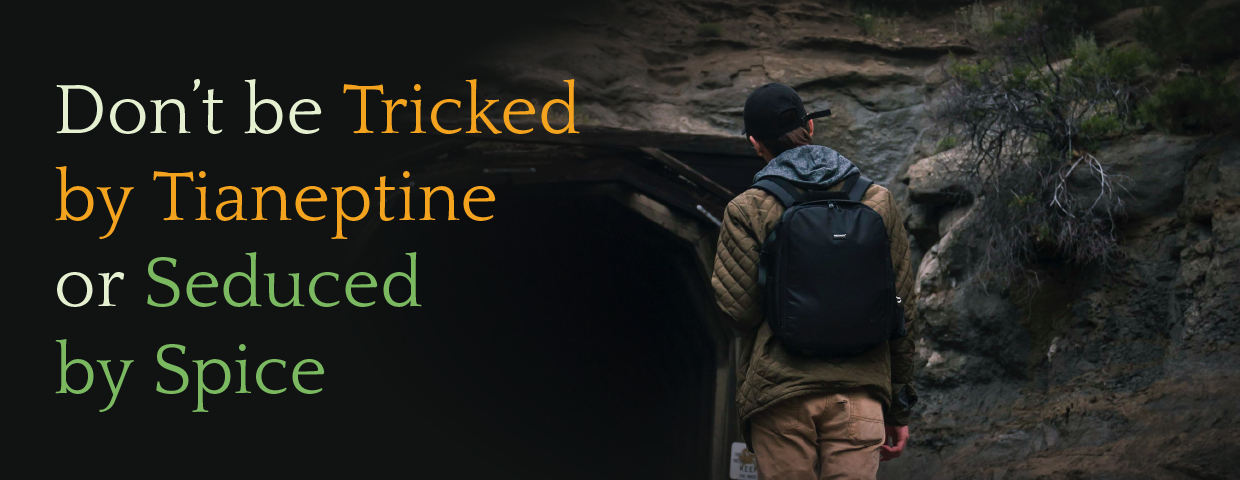
“Legal” doesn’t mean safe and will only cheat yourself onto a harder road toward recovery.
We have recently written about the ongoing opioid epidemic and how it has been growing throughout the pandemic. As we react to this increase in overdoses and deaths due to prescription drugs and controlled substances, new alternatives are cropping up on the streets and being purchased through international medical regulation loopholes.
Beyond the dangers of relapse and overdose, some of these new alternatives are “homemade” and can contain incredibly harmful substances that are toxic for humans to ingest or come into contact with. Combined with similar tolerance and withdrawal symptoms as found in opioids, these alternatives are incredibly dangerous and need to be recognized as such.
What are these drugs exactly?
Tianeptine is sold as an antidepressant or dietary supplement, but carries withdrawal and tolerance risks similar to opioids. Therefore it has been made illegal to prescribe in America and several other countries. Sold online and difficult to detect by standard drug screenings, this drug is taken in potentially lethal doses to mimic the effects of opioids.
Spice is known by a variety of names, including K2, and is a synthetic cannabinoid – a human-made chemical created to mimic the effects of marijuana. These chemicals are often sprayed on dried and shredded plant matter to be smoked, or vaporized in their liquid form. The manmade aspect of these chemicals and their use with other materials leads to unpredictable, dangerous, and even life-threatening effects.
Who uses these alternatives?
Addiction can happen to anyone. Those afflicted with opioid addiction may turn to tianeptine as an alternative drug, and studies show that men between the ages of 21 – 40 years old are most likely to abuse it. Spice and other synthetic cannabinoids have a stronger pull on the younger market of teens and young adults as it is marketed as fake or safe weed.
It’s important that those we love are educated on how dangerous and harmful these substances really are, and how the risks they carry are even greater than the drugs they are replacing when it comes to their health. Unknown additives and increased dosages can quickly lead to disaster, or make the road to sobriety more difficult to walk.
Signs & Symptoms to Look Out For
One of the greatest sources of strength on the road to recovery is the support received from friends and loved ones. Having those people in your life who will hold you accountable, and can be there for you to call on when you feel temptation rise is invaluable.
Here is a list of side affects you may notice from someone using these alternatives:
- Stomach Issues
- Abdominal pain
- Constipation
- Nausea
- Health Effects
- High blood pressure
- Rapid heart rate
- Difficulty sleeping
- Weight gain
- Dry mouth
- Mood Effects
- Agitation
- Depression
- Anxiety
- Violent behavior
- Mental Effects
- Dizziness
- Headaches
- Confusion
- Nightmares
Less common side effects include:
- Blurry vision
- Aching muscles
- Hot flashes
- Tremors
- Allergic skin reactions
- Difficulty urinating
- Kidney failure
- Liver inflammation
- Respiratory depression
- Seizures
- Coma
- Death
If someone is using these alternatives, and then cannot access them, you may see signs of withdrawal. Detox is the first step towards recovery, but withdrawal can be deadly. If you notice these signs, be sure that the individual displaying them is being well supported and taken care of during their detox timeline.
Withdrawal symptoms include:
- Nausea
- Vomiting
- Diarrhea
- Runny nose
- Watery eyes
- Dilated pupils
- Sweating
- Muscle Aches
- Fever
- Mood swings
- Difficulty Sleeping
- Yawning
Medication assisted treatment has been shown as an effective way to achieve sobriety when paired with therapy and a strong support network.
Everyone is at risk of falling into addiction. No one chooses to become an addict, but we can choose to stop being one. We can help others face their addictions and support them as they rise above them. We can be there for our loved ones and ourselves to live a life that is truly our own and not one weighed down by an addiction.

